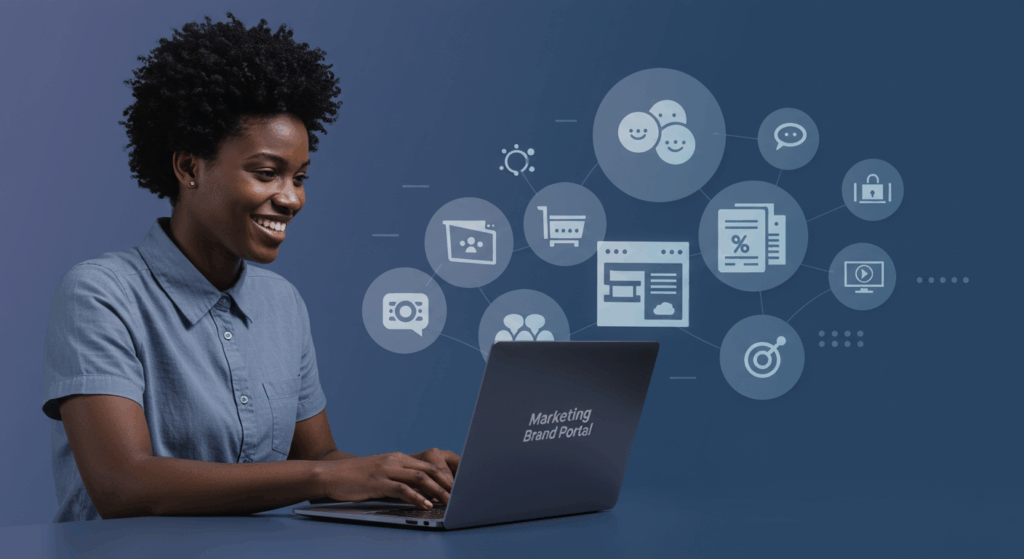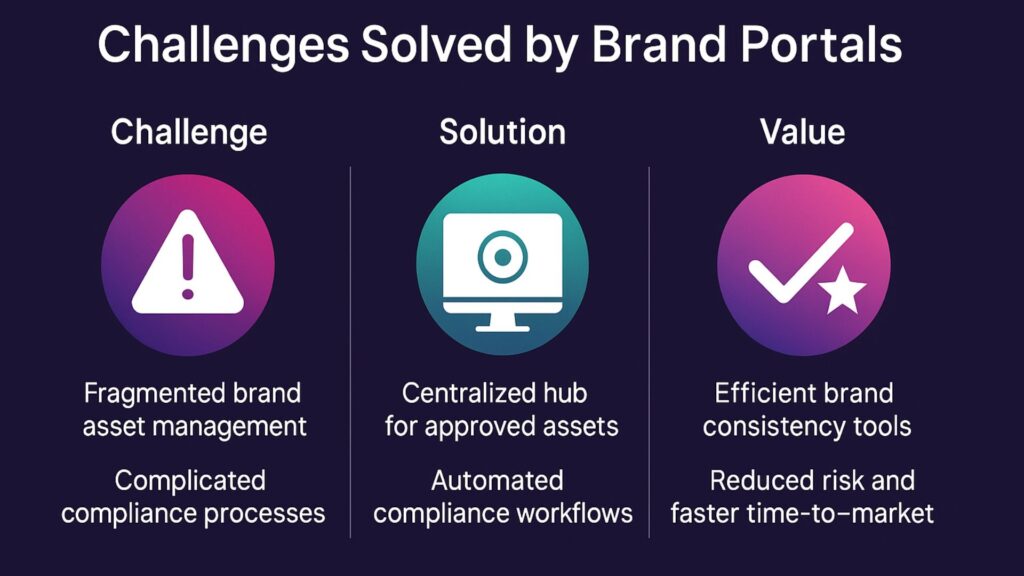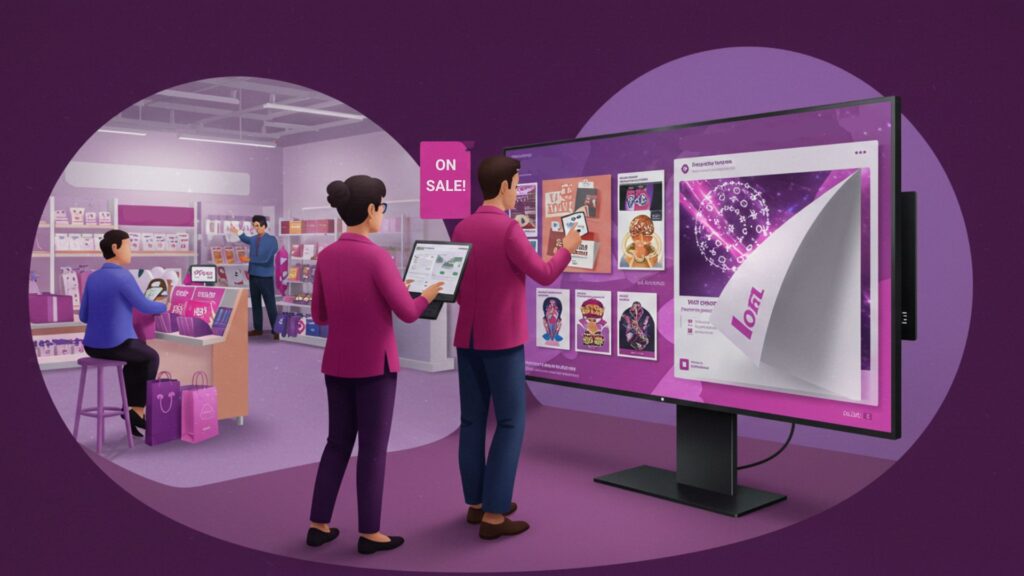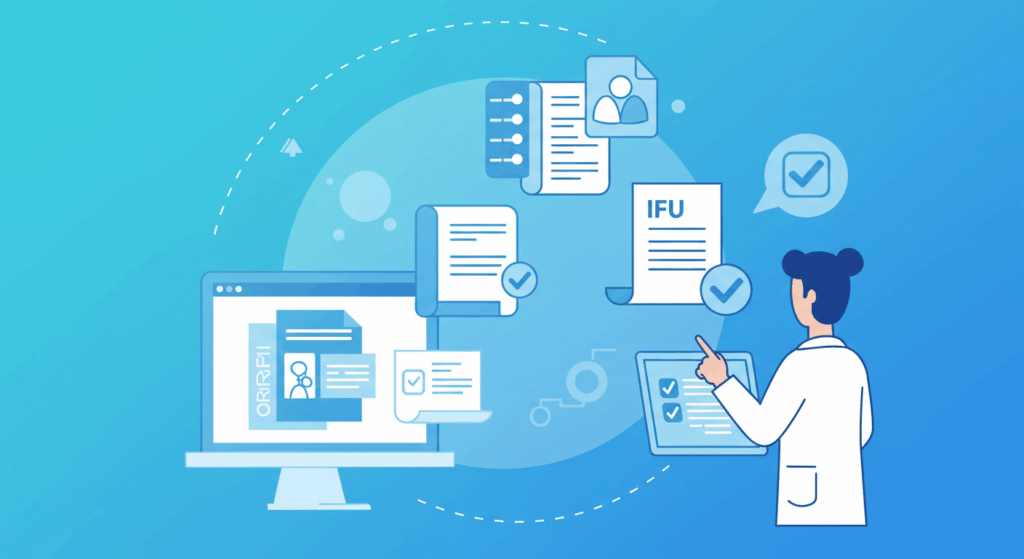Brand portals unify access, compliance, and collaboration to deliver consistent experiences at scale.
- They extend brand asset management by providing a single source of approved assets.
- Built-in brand consistency tools enforce guidelines and prevent off-brand usage.
- In retail, portals accelerate seasonal campaigns and franchise execution.
- In life sciences, they streamline MLR approvals and support audit-ready localization.
Organizations that want both speed and trust should make a digital brand portal the cornerstone of their content operations.
Brand consistency is a business driver. Consistent brand presentation across all platforms can increase revenue by up to 23%. Every logo, campaign template, and promotional asset is a lever for growth, recognition, and trust.
But here’s the thing: most organizations struggle to balance open access with brand control. Marketing, sales, and external partners need the right files at the right time, but without a central hub, compliance slips, duplication rises, and customer experiences lose cohesion. A brand portal bridges that gap, offering secure, curated access to approved assets so every stakeholder, from internal teams to global partners, delivers on-brand messaging with confidence.
What Is a Brand Portal?
Think of a brand portal as your company’s private file storage hub, complete with search functionality that actually works. It stores approved digital assets for use by marketing teams, salespeople, retail locations, or other internal and external marketing partners. Because it’s part of a broader brand asset management strategy, the portal ensures teams only work with the most accurate and approved versions of logos, templates, and files.
Brand assets are curated for use by user and role. The portal has permission settings to govern who can access and use the assets it stores.
For instance, a marketing manager might have access to the full asset collection, while other users have access to their campaign-specific files. Non-creative stakeholders like sales teams and marketing managers can deliver experiences and messaging to customers while adhering to brand identity.
How Do Brand Portal Features Work Within a Modern DAM Platform?
If digital asset management is the warehouse for your in-flight and completed assets, a brand portal is the delivery vehicle bringing those valuable assets to marketers. Where the repository features of DAMs provide access to brand assets at all production stages, the brand portal features of a first-in-class DAM platform make it easy to provide those approved assets and templates for broader use by marketing teams.

By selecting a DAM tool with robust functionality, you create a single source of truth for all your digital assets. A unified solution de-siloes data from several creative departments, allowing faster and safer delivery to end users, such as marketing and sales teams, customer service reps, external agencies, resellers, etc. Delivery can take place in a single environment, reducing redundant software tools and streamlining your brand management and content lifecycle.
Who Uses a Brand Portal?
The beauty of a brand portal? Stakeholders can help themselves. They log in, search for what they need, download it, and get back to work—no waiting, no bottlenecks. Generally, users log into a website or online content catalog, conduct dynamic searches on one or more search parameters, download the files they need, and deliver them to the intended audience.
Several parties within organizations use a brand portal to distribute approved assets:
- Marketers access the materials needed to push brand messaging, such as social media posts, thought leadership pieces, and advertising, out to the organization’s chosen marketing channels.
- Salespeople have searchable access to materials to share with customers. These resources help them educate customers and close deals.
- Customer service teams find support documents and promotional assets relevant to helping customers use and expand services.
- Brick and mortar store locations download and print assets for use in their advertising.
Do You Need a Brand Portal?
Ask any brand specialist when you should implement a digital asset management system, and they’ll probably say ‘yesterday’—or maybe even ‘last year. The more complex your brand and marketing needs, the more critical it becomes to stay organized and compliant.
When weighing the need to upgrade, here are seven signs your organization could benefit from a brand portal:
- You have a cross-functional marketing team. Immersive experiences are created when a dedicated team pulls together in the same direction. Managing a multi-faceted branding and marketing team is easier when you centralize and automate your content access.
- You have distributed, remote, or outsourced teams. Keeping an internal team organized through dedicated in-house servers may be feasible for a short time. However, distributed and remote teams need more resources, security, and speed to get their jobs done efficiently. Likewise, external agency partners need secure, curated access to assets. A brand portal provides the technological means to deliver the correct assets from anywhere.
- Your brand uses multi-channel or omnichannel marketing. Managing an omnichannel message requires marketing teams to access assets and brand resources to successfully deploy the message across video, text, social, email, and more. Centralizing your assets allows each stakeholder total visibility into the asset portfolio to deliver a positive experience across channels. Using a brand portal eliminates issues such as incorrect or outdated content appearing in marketing channels.
- You manage multiple products or brand strategies. As the business grows and more products join the portfolio, it’s vital to establish effective asset management for each. Likewise, if your brand relies on the strength of an umbrella or family branding strategy, centralizing branding allows teams to deliver the exact message they want across all brand properties. Cross-promotion and dynamic marketing strategies come together faster when teams can access the needed assets easily.
- Asset management is decentralized or fragmented. Nobody wants to go on a wild goose chase through email threads and random folders just to find one logo file. If finding assets feels like an expedition, it’s time for a change.
- Your company struggles with brand compliance. Adhering to brand standards within a large and fast-moving team is difficult. It’s further complicated without a centralized, curated management system for digital assets. If brand compliance slips through the cracks or makes tasks like localization difficult, it’s time for a better system.
- Cost and time savings are a top priority. Lost productivity and time are expensive and unnecessary side effects of ineffective asset management. If your organization needs to move quickly while preserving its budget, a brand portal is the best way to secure better outcomes without overspending.
Key Benefits of a Brand Portal
A modern DAM solution with strong portal functionality does more than just store your assets—it powers your entire marketing workflow, from the first creative spark to final delivery.
The right DAM gives creative teams a place to find the in-development assets they need, communicate clearly across departments, understand the objectives and timeline for every project, and create assets that fit campaign needs and goals. It also enables teams to provide those deliverables to non-creative stakeholders with ease.
Seamless collaboration: The brand portal serves as a bridge between creative teams that develop assets and other teams that use them. It offers a safe way for creative teams to confidently deliver the right assets to non-creative users, external stakeholders, and customers.
Secure communications: In the new, global world of work, secure communication and document access are vital to smooth operations. The modern brand portal allows stakeholders to work from anywhere with confidence, transmit and secure assets with best-in-class encryption, and deliver experiences to customers from anywhere.
Brand continuity: Let’s be real: brand continuity matters. A lot. This is where brand consistency tools within a digital brand portal prove invaluable, automatically applying guidelines and permissions so that every asset delivered is on-brand by design. When brand judgments are made in fractions of a second and over 80% of consumers know brands by their color before their name, there is very little margin for error in delivering a consistent, on-brand experience.
With advanced guidelines built into a brand portal, creative assets come together without endless revisions or continuity checks. The system puts the proper guardrails in place to ensure all messaging adheres to the brand’s style guide without stifling creativity or slowing the production cycle.
Easier campaign planning: Modern marketing campaigns are larger and more complex than ever. Coordinating the development and launch of a new campaign from a centralized brand portal allows teams to see campaigns holistically. This visibility helps them plan and execute on budget, using the right resources to deliver a first-class customer experience.
Faster time-to-market: With the increased efficiency and communication of a centralized brand portal, projects go from planning to execution quickly. This allows teams to bring products to market faster and get results with a better return on investment.
Quick Guide to Key Benefits
| Challenge | How a Brand Portal Helps | Value Delivered |
| Teams using outdated or off-brand assets | Built-in brand consistency tools apply guidelines automatically | Fewer errors and stronger brand trust |
| Fragmented asset storage across drives and emails | Centralized brand asset management with secure permissions | Time saved, faster asset retrieval |
| Compliance risks in regulated industries | Audit trails, MLR-approved workflows, automated checks | Reduced legal exposure and audit readiness |
| Slow campaign execution across teams | Self-service access and modular templates | Faster time-to-market and higher productivity |

What Are the Most Common Brand Portal Use Cases?
Brand management: With a brand portal, creative teams can confidently hand off approved assets to the people who actually push them out into the world—marketing teams, sales reps, and partners. With a portal, your internal and external marketing stakeholders deliver customer experiences and brand communications that move the needle on revenue and customer engagement.
Modular asset management: Use a portal to deliver customizable content and ready-to-use templates that allow compliant repurposing of assets, images, and text. Access to modifiable assets allows users to create localized and personalized marketing touchpoints that remain consistent with brand guidelines and across channels.
Media repository: Non-creative stakeholders such as sales and customer service teams need access to media, marketing slicks, blog content, and other creative assets to connect with prospects and customers. A portal delivers access only to approved-for-use assets, meaning individuals and teams have access to only the assets approved for use within their functions.
External end users: A brand portal safely distributes materials to outside stakeholders such as resellers and brand partners. A cloud service delivers these assets, so they are transmitted safely and accurately. Outside partners have the tools they need to successfully resell products, so they don’t need to develop materials independently.
Why Retail Teams Rely on Brand Portals for Consistency and Speed
Retail brands manage a constant cycle of product launches, seasonal campaigns, and promotional updates. A digital brand portal provides the structure needed to execute these initiatives consistently across every location and partner network.
Franchise and store managers don’t need to reinvent the wheel. The portal hands them everything they need—pre-approved POS materials, signage, planograms—ready to go. Instead of chasing down files or relying on outdated collateral, teams can quickly download the most current campaign assets and put them into market. You can reduce errors and ensure every display and advertisement reflects the same brand identity. By combining brand consistency tools with centralized brand asset management, retailers can scale seasonal swaps and promotions without introducing inconsistencies at the local level.

Co-op marketing programs also benefit from centralized access. Local retailers can pull compliant templates, add regional details, and submit for automated approval, all within the portal. Centralization speeds up turnaround times, safeguards brand integrity, and helps campaigns go live faster. Whether it’s a seasonal swap, a new product rollout, or a flash promotion, a digital brand portal acts as the single source of truth that keeps retail execution aligned, agile, and on-brand.
Why Digital Brand Portals Matter in Regulated Life Sciences Workflows
In life sciences, every piece of content must meet strict medical, legal, and regulatory (MLR) requirements. A digital brand portal ensures that only approved, compliant assets reach the market, reducing risk while accelerating time-to-market.
For marketing and medical affairs teams, portals provide a secure way to distribute MLR-cleared collateral, clinical imagery, or product claims. Field reps can quickly access the most recent brochures, educational materials, and product labeling without worrying about outdated or non-compliant files. This protects both the brand and the customer experience.

Global operations also benefit from streamlined localization. A portal makes it possible to adapt instructions for use (IFUs), packaging, or promotional content to meet regional requirements while maintaining consistency with the master brand. Audit-ready trails, permissions, and automated review workflows provide additional guardrails, ensuring every localized asset can withstand regulatory scrutiny. Integrated brand asset management makes it easier to track which files have passed MLR review, while brand consistency tools guarantee that regional variations still align with the global master brand.
How Do Brand Portals Support Compliance and Collaboration?
A brand portal supports compliance by enforcing permissions, version control, and audit trails. Only approved, up-to-date assets are available, reducing the risk of off-brand or non-compliant content slipping into the market. Automated review workflows and governance guardrails ensure assets meet regulatory requirements before distribution.
At the same time, portals enhance collaboration by giving every stakeholder secure self-service access to the files they need. A protected hub eliminates delays caused by manual requests, reduces duplication of effort, and allows teams to coordinate campaigns in real time. By combining compliance controls with collaborative access, brand portals help organizations deliver consistent, trustworthy customer experiences faster.
Frequently Asked Questions
How do brand portals support compliance and collaboration? A brand portal enforces permissions, version control, and audit trails to ensure only approved assets are used. It also gives teams and partners self-service access, streamlining collaboration while protecting brand integrity.
What is the difference between a digital brand portal and a DAM system? A digital brand portal is the outward-facing layer of a DAM system. While DAM manages all assets across their lifecycle, the portal makes approved content available to internal and external teams in a secure, user-friendly way.
What brand consistency tools are typically included in a brand portal? Most portals include brand guidelines, pre-approved templates, and automated checks for file types, colors, and logos. These brand consistency tools ensure every campaign asset aligns with the master brand, no matter who creates or distributes it.
Turning Brand Portals Into a Growth Driver
A digital brand portal is a safeguard for compliance, a hub for collaboration, and a tool that empowers every team to deliver consistent experiences at scale. Whether supporting retail networks with on-brand campaigns or enabling life sciences organizations to meet regulatory demands, the right portal ensures speed and accuracy without sacrificing control.At Aprimo, we help organizations get the most out of their brand portals by integrating them into an intelligent content operations platform that actually makes sense. With AI-powered governance, automated workflows, and deep integrations, we make it easy to keep every asset discoverable, compliant, and ready for market. Request a demo today and see how Aprimo can help.


